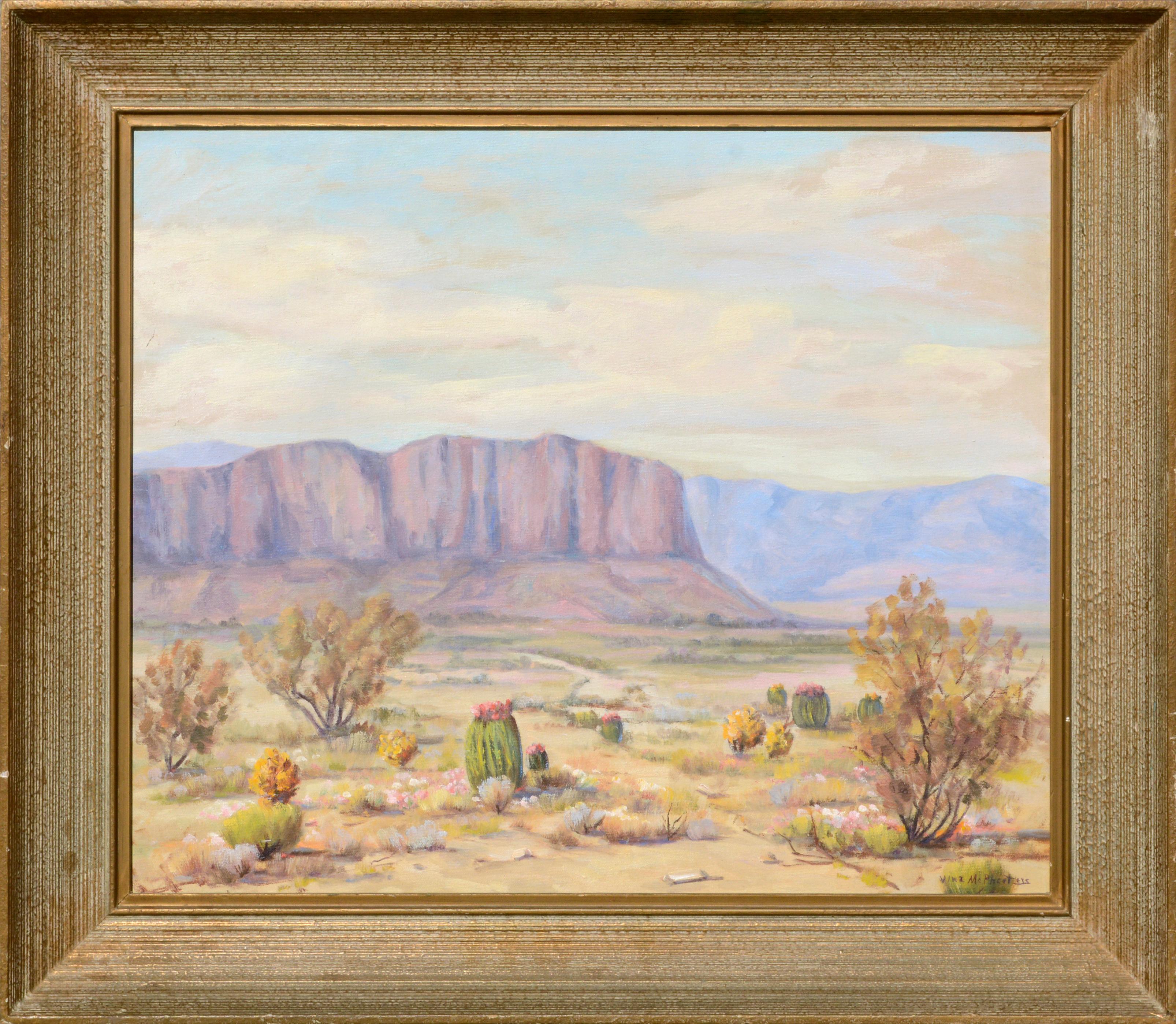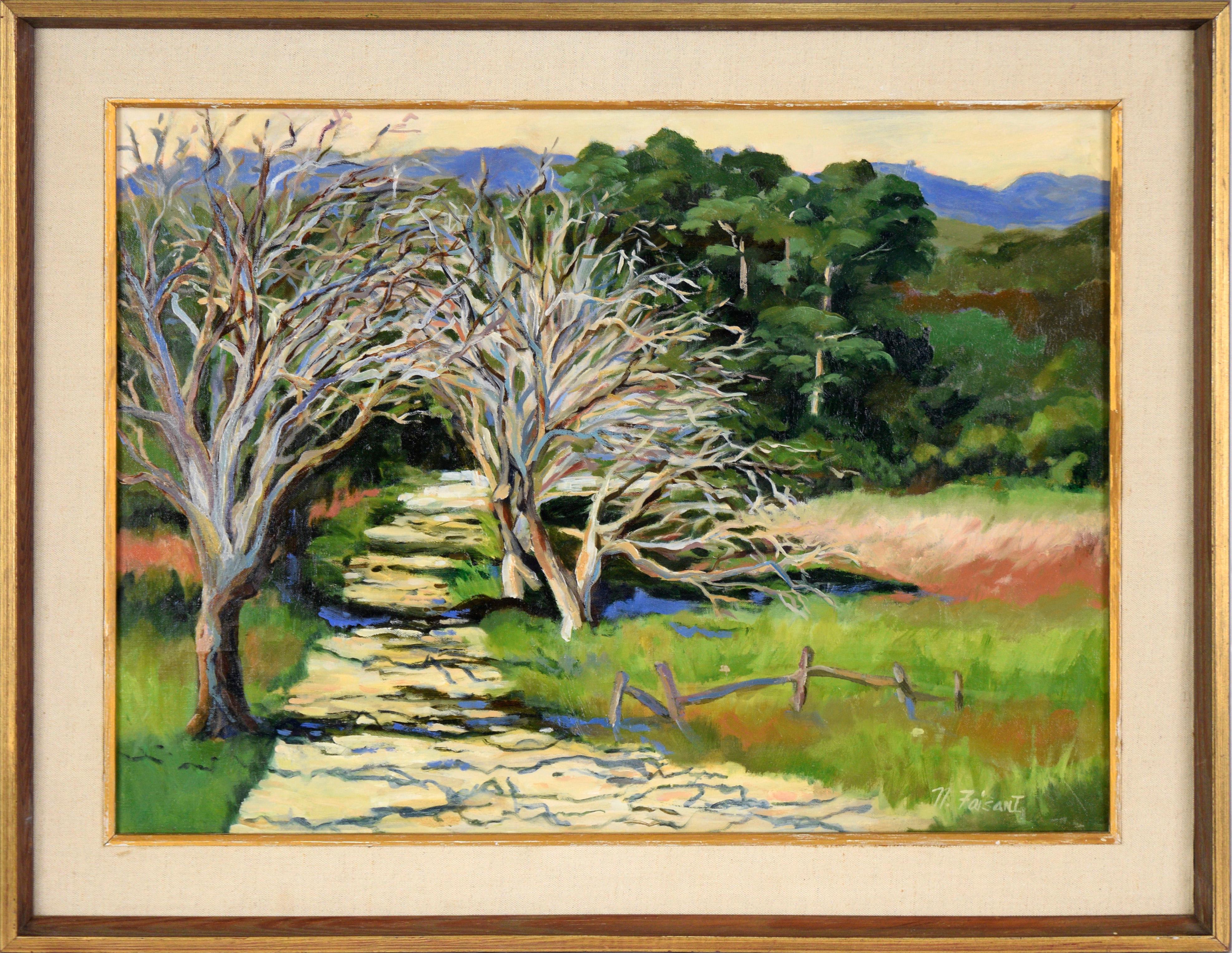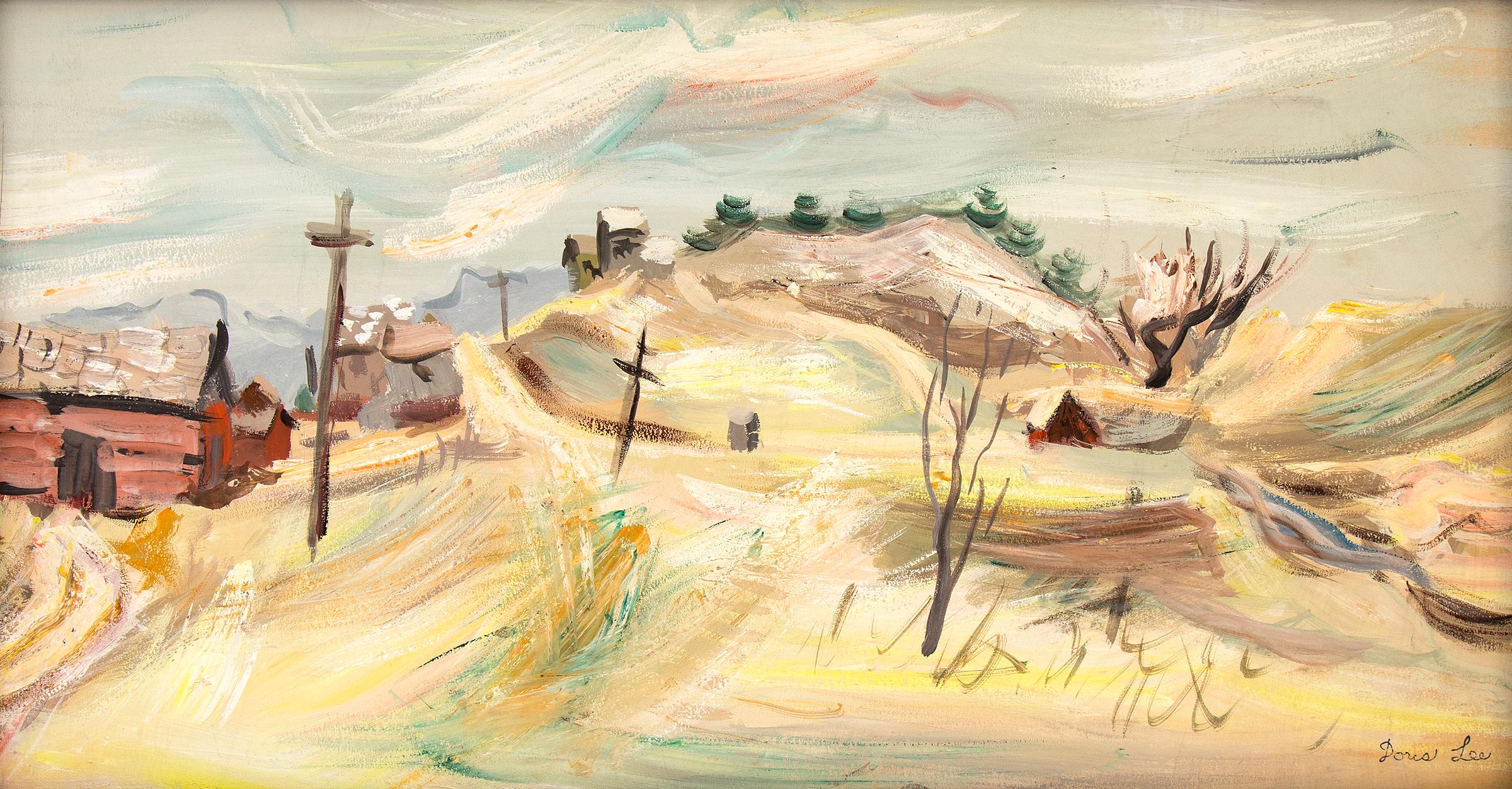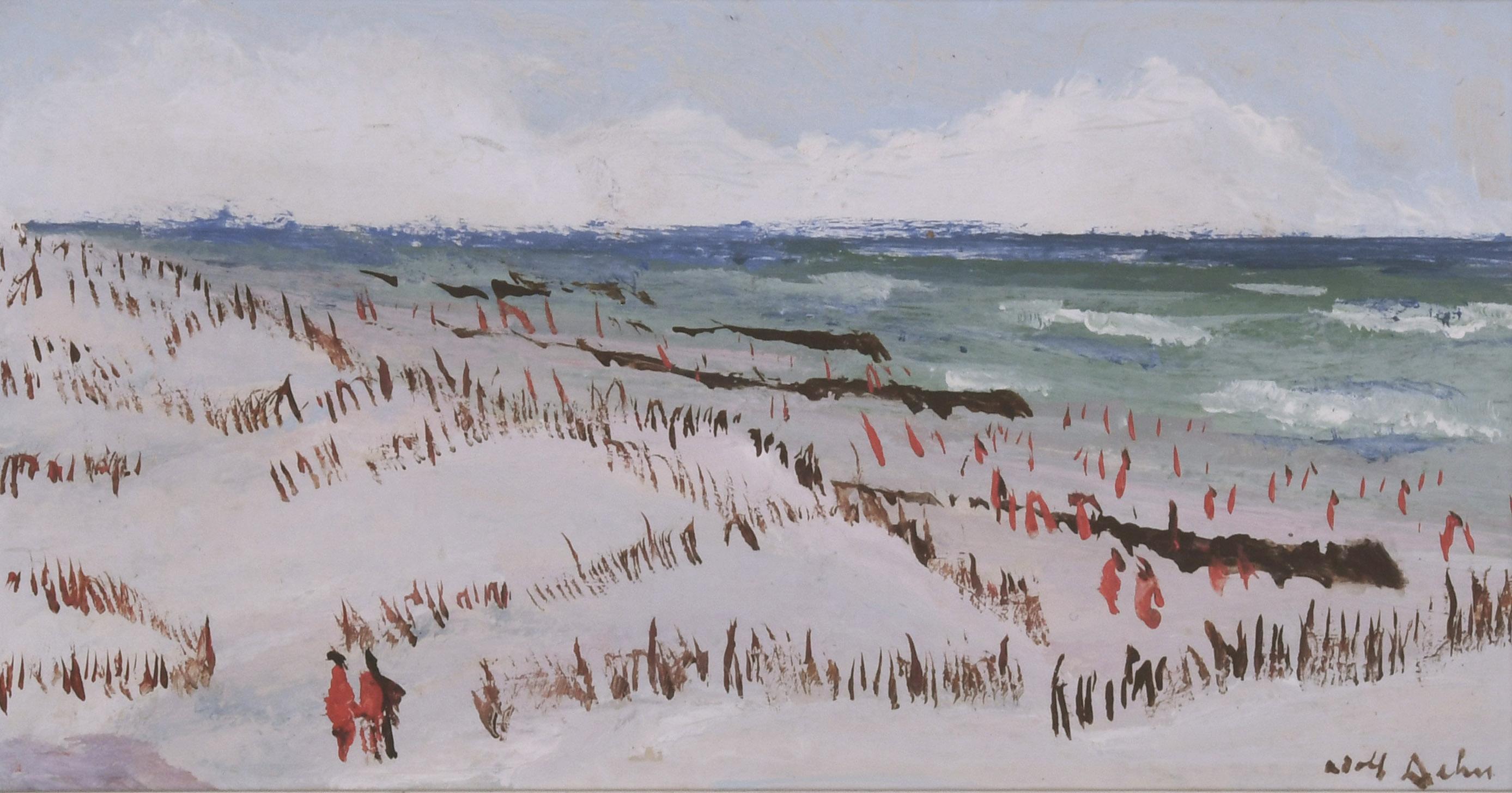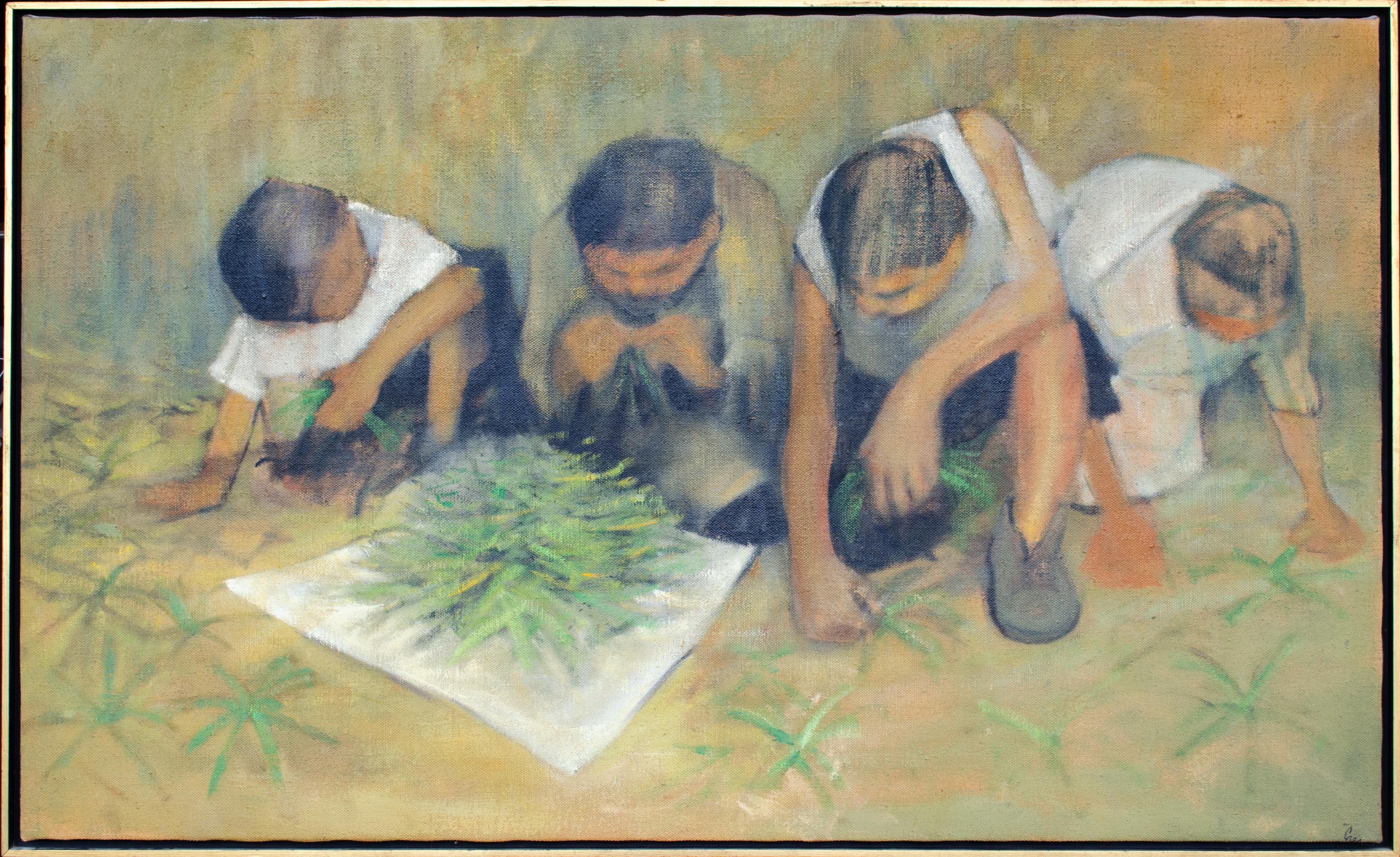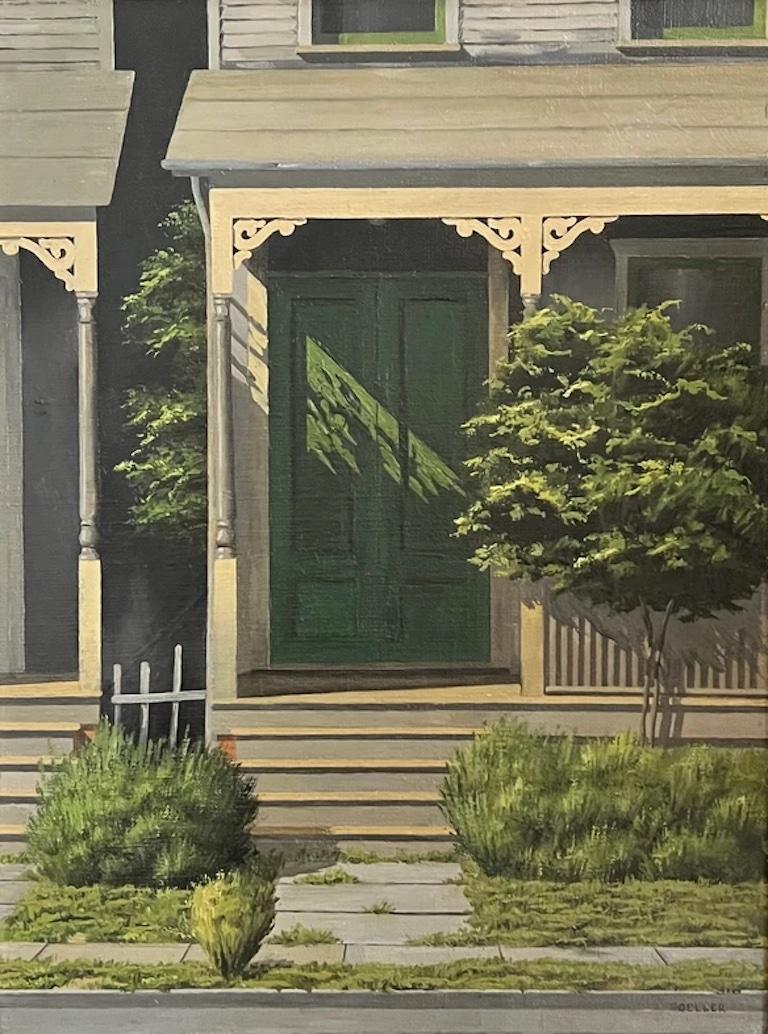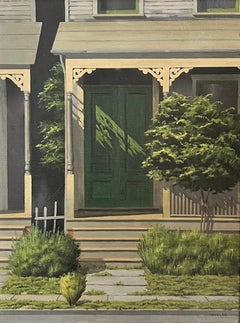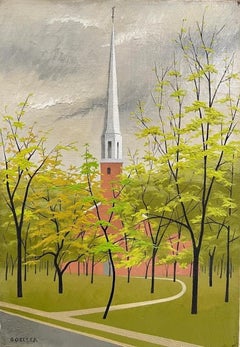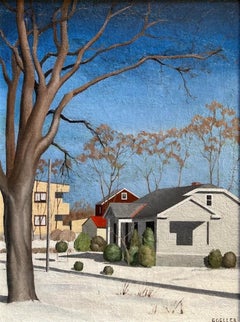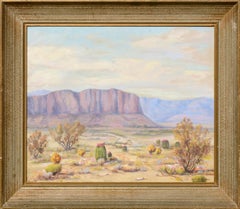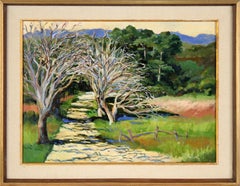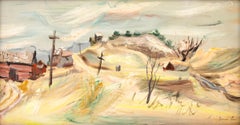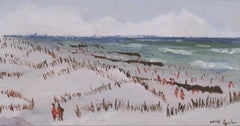Items Similar to Exterior Stairway
Want more images or videos?
Request additional images or videos from the seller
1 of 5
Edward BibermanExterior Stairwayc. 1970s
c. 1970s
About the Item
Exterior Stairway, c. 1970s, oil on masonite, signed upper right, 12 x 24 inches; illustrated (film) Kaufman, Jeffrey, Brush with Life: The Art of Being Edward Biberman, 2007, (DVD release 2010), 85 minutes
This work is part of our exhibition The Architectural World of Edward Biberman (1904 - 1986)
About the Painting
Exterior Stairway is a prime example of Biberman’s post-war precisionist scenes of Southern California, similar in feeling to The White Fire Escape, which has been in the collection of the Los Angeles County Museum of Art for more than fifty years. Biberman began working with a precisionist vocabulary in New York during the early 1930s upon his return from Paris. During his long career, Biberman consistently depicted architectural subjects as part of his practice. Critics have favorably compared these paintings to 1920s and 30s precisionism as practiced by Charles Sheeler, Louis Lozowick and Ralston Crawford, and noted that Biberman’s early Southern California modernist scenes anticipated those of Ed Ruscha and David Hockney. In a rare commentary on the work of other artists, Biberman himself acknowledged a debt to the great precisionist painter, Charles Demuth. In a 1975 interview, likely around the same time he painted Exterior Stairway, Biberman explained, “[T]here was a painter who deserves to be much better known, the American painter Charles Demuth. [He] painted a canvas that I saw when I was quite young. It was a painting of two great wheat silos, probably someplace in Kansas, and he titled that painting My Egypt. Now, I knew exactly what he meant by that. When I say I've always been fascinated by cities, engineering, [and] structural forms, I speak of something that has, emotionally, touched me very deeply. This interest has always been present in my work when I am not impelled, let us say, to paint things with an overtly social quality. You see, I think of myself as a very lyric painter. I love the look of nature, and I also love the look of many of the things that men build. I find both of these very wonderful, stirring, lyrical experiences.” In Exterior Stairway, we see the lyricism that Biberman found in both the structure of a conventional Southern California parking garage and Los Angeles’ iconic palm trees.
About the Artist
Edward Biberman was one of California’s most important modernist painters. He was born in Philadelphia, the son of Russian Jewish immigrants. Biberman’s artistic career started at the Pennsylvania Academy of Fine Arts followed by three years of study in Paris, where he associated closely with Calder and Noguchi and exhibited at the Salon d'Automne, Grand Palais, in 1927 and the Salon des Independents in 1929. Upon his return to the United States, Biberman spent time in New York City, where he showed at many of the city’s premier galleries and museums. His works were selected for several of the Museum of Modern Art’s early exhibitions of American artists, including 46 Painters and Sculptors Under the Age of 35 (1930) and Murals by American Painters and Photographers (1932). Hoping to escape the pressures of the New York art world, Biberman moved to Los Angeles in 1936 where he could be close to his family, including his film director brother, Herbert Biberman, and his sister-in-law, the Academy Award winning actress, Gale Sondergaard.
During the course of his long career, Biberman showed at the Salon d’Automne (Paris); the Whitney Museum of American Art; Metropolitan Museum of Art (New York), Corcoran Gallery, Los Angeles County Museum of Art (LACMA) and dozens of other museums and galleries across the US and in Europe. He enjoyed over forty-five solo exhibitions and his works were included in over one hundred group shows. Biberman completed three murals for public works projects, including his work Abbot Kinney and the Story of Venice for the Venice Post Office, which was installed for six months at LACMA in 2014. His works are in the permanent collections of more than a dozen museums, including the Museum of Fine Arts, Houston, National Portrait Gallery (of the Smithsonian Institution), Butler Institute of American Art, Pennsylvania Academy of Fine Arts and LACMA. Several books are dedicated to Biberman’s art, as is a feature length documentary, Brush with Life: The Art of Being Edward Biberman (2007). Biberman’s art has undergone a resurgence of popularity during the past fifteen years with four solo or focused exhibitions, Edward Biberman Revisited (2009), Edward Biberman (2011-12), Lost Horizons: Mural Dreams of Edward Biberman (2014) and Edward Biberman, Abbot Kinney and the Story of Venice (2014), and representation in a number of other exhibitions, such as George Ault and 1940s America at the Smithsonian Institution (2011), Pacific Standard Time (2012) and Contraption: Rediscovering California Jewish Artists (2018). He is listed in Who was Who in American Art and all other standard references. Biberman’s portrait of Martin Luther King, I Have a Dream, is currently on view at LACMA at part of Black American Portraits, a companion exhibition to the Obama presidential and first lady portraits.
Biberman’s brand of modernism can fairly be divided into four categories 1) precisionist urban scenes of New York and Southern California which celebrate the creations of humanity; 2) portraits which expose not only the historical context, but also the souls, of his subjects; 3) rural landscapes and still life paintings which portray the beauty of America and its flora; and 4) social realist works which explore the struggles, hopes and shortcomings of our society. Regardless of genre, Biberman had a unique sense of structure and color. His figures are at the same time specific and universal. Taken as a whole, Biberman’s body of work presents the viewer with a compelling and often daring vision of 20th century America and its art.
- Creator:Edward Biberman (1904 - 1986, American)
- Creation Year:c. 1970s
- Dimensions:Height: 24 in (60.96 cm)Width: 12 in (30.48 cm)Depth: 1 in (2.54 cm)
- Medium:
- Movement & Style:
- Period:
- Condition:
- Gallery Location:Los Angeles, CA
- Reference Number:1stDibs: LU1859210018112
About the Seller
5.0
Vetted Professional Seller
Every seller passes strict standards for authenticity and reliability
1stDibs seller since 2022
15 sales on 1stDibs
Typical response time: 19 hours
- ShippingRetrieving quote...Shipping from: Los Angeles, CA
- Return Policy
Authenticity Guarantee
In the unlikely event there’s an issue with an item’s authenticity, contact us within 1 year for a full refund. DetailsMoney-Back Guarantee
If your item is not as described, is damaged in transit, or does not arrive, contact us within 7 days for a full refund. Details24-Hour Cancellation
You have a 24-hour grace period in which to reconsider your purchase, with no questions asked.Vetted Professional Sellers
Our world-class sellers must adhere to strict standards for service and quality, maintaining the integrity of our listings.Price-Match Guarantee
If you find that a seller listed the same item for a lower price elsewhere, we’ll match it.Trusted Global Delivery
Our best-in-class carrier network provides specialized shipping options worldwide, including custom delivery.More From This Seller
View AllAcross the Street
Located in Los Angeles, CA
This painting is part of our exhibition Charles Goeller: A Wistful Loneliness.
Oil on canvas, 16 x 12 inches, Signed lower right
Exhibited:
1) [Solo E...
Category
1940s American Modern Landscape Paintings
Materials
Oil, Canvas
Church in Trees
Located in Los Angeles, CA
This painting is part of our exhibition Charles Goeller: A Wistful Loneliness.
Oil on canvas, 13 x 9 inches, Signed lower left
Category
1940s American Modern Landscape Paintings
Materials
Oil, Canvas
Suburb (in Winter)
Located in Los Angeles, CA
This painting is part of our exhibition Charles Goeller: A Wistful Loneliness.
Oil on canvas, 20 x 15 inches, Signed lower right
Exhibited:
1) Portrai...
Category
1940s American Modern Landscape Paintings
Materials
Oil
Johnny Walker’s Place
By Georgina Klitgaard
Located in Los Angeles, CA
Johnny Walker’s Place, by 1929, oil on canvas, signed lower right, 34 x 42 inches, exhibited 1) 28th International Exhibition of Paintings, Carnegie Institute, Pittsburgh, PA, Octobe...
Category
1920s American Modern Landscape Paintings
Materials
Canvas, Oil
Summer in Town
Located in Los Angeles, CA
Summer in Town, 1943, oil on board, signed and dated lower right, 13 ¾ x 22 inches, titled and dated verso, exhibited: 1) 139th Annual Exhibition, Pennsylvania Academy of Fine Arts, ...
Category
1940s American Modern Landscape Paintings
Materials
Oil, Board
Rites of Winter
By Georgina Klitgaard
Located in Los Angeles, CA
Rites of Winter, by 1939, oil on canvas, 32 x 40 inches, exhibited: 134th Annual Exhibition of the Pennsylvania Academy of Fine Arts, Philadelphia, PA, January 29 – March 5, 1939, no...
Category
1930s American Modern Landscape Paintings
Materials
Canvas, Oil
You May Also Like
Mid Century Desert Mesa Landscape with Cacti in Oil on Canvas
By Vina McPheeters
Located in Soquel, CA
Mid Century Desert Mesa Landscape with Cacti in Oil on Canvas
Colorful mid century desert landscape with beautiful cacti by Vina McPheeters (American, 1892-1964). Colorful cacti are dotted throughout the foreground, lush with yellow and pink blooms. In the distance, dramatic mesas rise to meet a cloud-filled sky.
Signed "Vina McPheeters" in the lower right corner.
Presented in an antiqued bronze-colored frame.
Frame size: 25.75"H x 29.75"W
Image size: 20"H x 24"W
Vina Pearl McPheeters (American, 1892-1964) was born in Iowa on October 7, 1892. Vina was the wife of Robert Guy...
Category
1950s American Modern Landscape Paintings
Materials
Canvas, Oil, Stretcher Bars
Shaded Path in the California Hills - Original Oil on Canvas (Laid on Board)
Located in Soquel, CA
Shaded Path in the California Hills - Oil on Canvas (Laid on Board)
Beautiful and colorful California landscape of trees lining a path by Palo Alto and Monterey artist Nancy Faisant...
Category
Late 20th Century American Modern Landscape Paintings
Materials
Canvas, Oil, Board
Framed Modernist Oil Painting of Colorado Mountain Town, Summer Landscape Art
By Doris Lee
Located in Denver, CO
This original oil on board painting by acclaimed American artist Doris Emrick Lee depicts a vibrant Colorado mountain town bathed in warm summer light. T...
Category
20th Century American Modern Landscape Paintings
Materials
Oil
Jersey Shore III
By Adolf Arthur Dehn
Located in Fairlawn, OH
Jersey Shore III
Casein on Masonite, 1967
Signed lower right (see photo)
Initialed, dated and titled verso
Provenance:
Estate of the artist
Virginia Dehn (the artist's widow)
Dehn Quests
Created on location on the Jersey Shore. The Jersey Shore was the main playground for thousand to escape the summer heat of New York. This small painting shows Dehn's mastery of patterning color to depict movement and recreation. Part of a suite of paintings done on this theme. Within a year of it's creation, Dehn dies from a heart attack.
Casein on Masonite
Condition: Excellent
Image: 6 x 11"
Frame: 9 3/8 x 14 1/2"
Adolf Dehn, American Watercolorist and Printmaker, 1895-1968
Adolf Dehn was an artist who achieved extraordinary artistic heights, but in a very particular artistic sphere—not so much in oil painting as in watercolor and lithography. Long recognized as a master by serious print collectors, he is gradually gaining recognition as a notable and influential figure in the overall history of American art.
In the 19th century, with the invention of the rotary press, which made possible enormous print runs, and the development of the popular, mass-market magazines, newspaper and magazine illustration developed into an artistic realm of its own, often surprisingly divorced from the world of museums and art exhibitions, and today remains surprisingly overlooked by most art historians. Dehn in many regards was an outgrowth of this world, although in an unusual way, since as a young man he produced most of his illustrative work not for popular magazines, such as The Saturday Evening Post, but rather for radical journals, such as The Masses or The Liberator, or artistic “little magazines” such as The Dial. This background established the foundation of his outlook, and led later to his unique and distinctive contribution to American graphic art.
If there’s a distinctive quality to his work, it was his skill in introducing unusual tonal and textural effects into his work, particularly in printmaking but also in watercolor. Jackson Pollock seems to have been one of many notable artists who were influenced by his techniques.
Early Years, 1895-1922
For an artist largely remembered for scenes of Vienna and Paris, Adolf Dehn’s background was a surprising one. Born in Waterville, Minnesota, on November 22, 1895, Dehn was the descendent of farmers who had emigrated from Germany and homesteaded in the region, initially in a one-room log cabin with a dirt floor. Adolf’s father, Arthur Clark Dehn, was a hunter and trapper who took pride that he had no boss but himself, and who had little use for art. Indeed, during Adolf’s boyhood the walls of his bedroom and the space under his bed were filled with the pelts of mink, muskrats and skunks that his father had killed, skinned and stretched on drying boards. It was Adolf’s mother, Emilie Haas Dehn, a faithful member of the German Lutheran Evangelical Church, who encouraged his interest in art, which became apparent early in childhood. Both parents were ardent socialists, and supporters of Eugene Debs...
Category
1960s American Modern Landscape Paintings
Materials
Oil
Panoramic Painting of the Harvest by Leonard Creo
Located in New York, NY
Leonard Creo (American, 1923-2019)
Untitled, c. 1960s
Oil on canvas
29 x 48 in.
Framed: 30 1/8 x 49 1/4 x 1 1/2 in.
Signed lower right: Creo
Creo was bor...
Category
1960s American Modern Landscape Paintings
Materials
Canvas, Oil
"Spring" Milton Derr, Lyrical Modernist Landscape, Bright Green and Blue Hues
Located in New York, NY
Milton Derr
Spring, 1982
Signed lower right; titled and dated verso
Oil on canvas
26 x 28 inches
Provenance
Acquired by descent from the artist to the present owner
Milton Derr wa...
Category
1980s American Modern Figurative Paintings
Materials
Canvas, Oil
Recently Viewed
View AllMore Ways To Browse
Modern Exterior
Edward Hoper
1940s Landscape Painting California
1920s California Landscape Paintings
Fire Escape Used
Modern Paintings Palm Trees
C Crawford
1930s Actress
David Hockney Los Angeles
David Hockney Tree
Portraits Of Men 1930
Noguchi 1
Vintage Parking Signs
Obama Hope
Escape From Egypt
Paintings With Silos
Kinney Oil
Precisionist Painting
